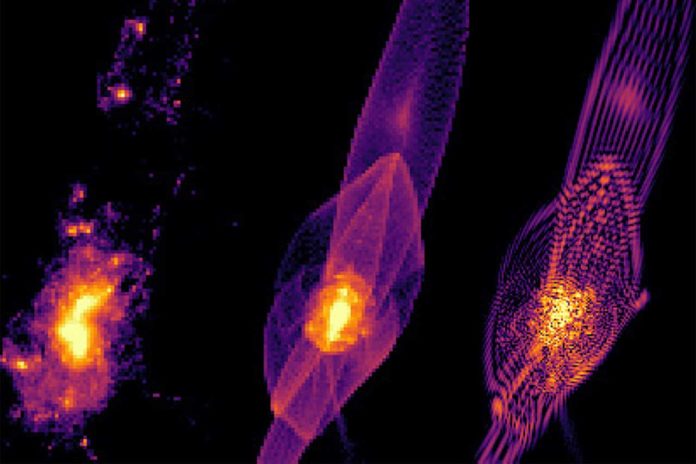Dark Matter is viewed as the spine to the structure of the universe. Although, scientists know very little about its inclination, as the particles have so far sidestepped detection.
Now, MIT scientists came to know that early universe and early galaxies, must have appeared slightly different depending on the nature of Dark Matter. They even have simulated what early galaxy formation would have looked like if dark Matter were fuzzy, rather than cold or warm.
In the most generally acknowledged scenario, dark matter is cold, comprised of moderate moving particles that, besides gravitational effects, have no cooperation with ordinary Matter. Warm Dark Matter is believed to be a somewhat lighter and quicker form of cold dark matter. And fuzzy dark Matter, is something completely different, comprising of ultralight particles, each around one octillionth (10-27) the mass of an electron.
In their simulations, the analysts found that if dark Matter is cool, then galaxies in the early universe would have formed in nearly spherical halos. However, if the nature of dark Matter is fuzzy or warm, the early universe would have looked slightly different, with galaxies forming first in broadened, tail-like fibers. In a fluffy universe, these filaments would have seemed striated, similar to star-lit strings on a harp.
Mark Vogelsberger, associate professor of physics at MIT’s Kavli Institute for Astrophysics and Space Research, said, “The first galaxies in the early universe may illuminate what type of dark Matter we have today. Either we see this filament pattern, and fuzzy dark Matter is plausible, or we don’t, and we can rule that model out. We now have a blueprint for how to do this.”
Anastasia Fialkov of Cambridge University said, “The nature of Dark Matter is still a mystery. Fundamental physics motivates fuzzy dark Matter, for instance, string theory, and this is an interesting dark matter candidate. Cosmic structures hold the key to validating or ruling out such dark matter models.”
To see how different a cold and a fuzzy early universe could be, scientists simulated a small, cubic space of the early universe, measuring about 3 million light-years across, and ran it forward in time to see how galaxies would form given one of the three dark matter scenarios: cold, warm, and fuzzy.
Scientists started each simulation by assuming a particular distribution of dark matter, which scientists have some idea of, based on measurements of the cosmic microwave background — “relic radiation” that was emitted by and was detected just 400,000 years after the Big Bang.
Vogelsberger said, “Dark Matter doesn’t have a constant density, even at these early times. There are tiny perturbations on top of a constant density field.”
Scientists modified their simulation of cold dark Matter, enabling it to solve two other equations to simulate galaxy formation in a fuzzy dark matter universe. The first, Schrödinger’s equation, describes how a quantum particle acts as a wave, while the second, Poisson’s equation, explains how that wave generates a density field or distribution of dark matter, and how that distribution leads to gravity — the force that eventually pulls in Matter to form galaxies. They then coupled this simulation to a model that describes the behavior of gas in the universe, and the way it condenses into galaxies in response to gravitational effects.
In all three scenarios, galaxies formed wherever there were over-densities or large concentrations of gravitationally collapsed Dark Matter.
Vogelsberger said, “Similar to warm dark Matter, fuzzy dark Matter formed stars along filaments. But then quantum wave effects took over in shaping the galaxies, which formed more striated filaments, like strings on an invisible harp. This striated pattern is due to interference, an effect that occurs when two waves overlap. When this occurs, for instance, in waves of light, the points where the crests and troughs of each wave align form darker spots, creating an alternating pattern of bright and dark regions.”
“In the case of fuzzy dark matter, instead of bright and dark points, it generates an alternating pattern of over-dense and under-dense concentrations of dark matter.”
“You would get a lot of gravitational pull at these over-densities, and the gas would follow, and at some point would form galaxies along those over-densities, and not the under-densities. This picture would be replicated throughout the early universe.”
“It’s this observational test we can provide for the nature of dark matter, based on observations of the early universe, which will become feasible in the next couple of years.”
